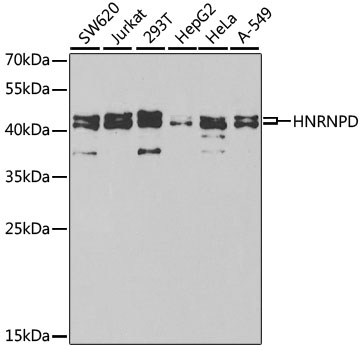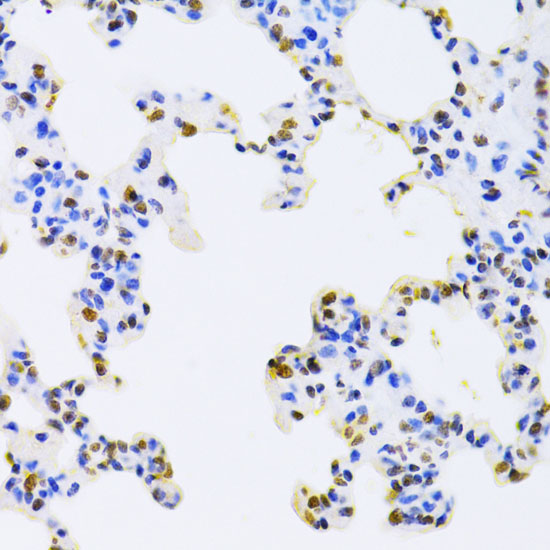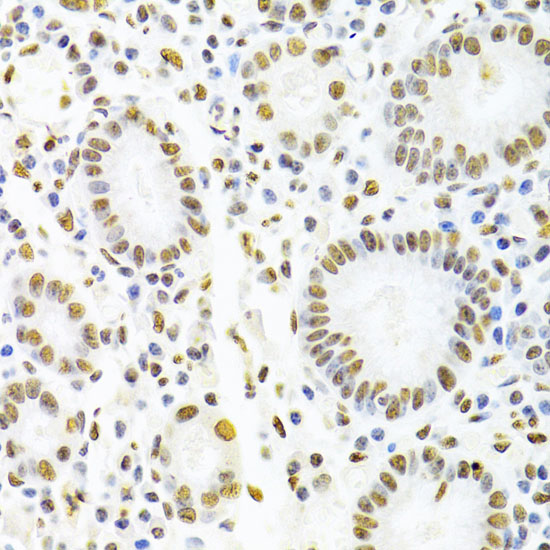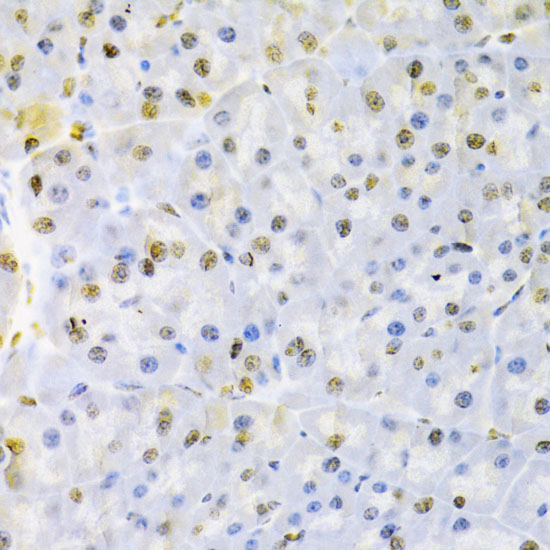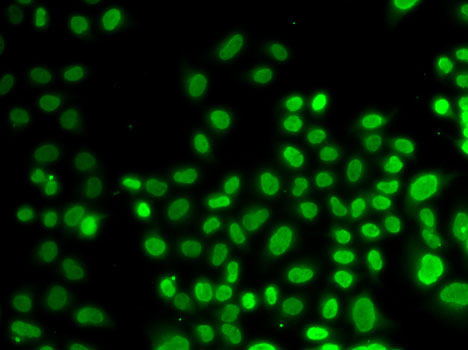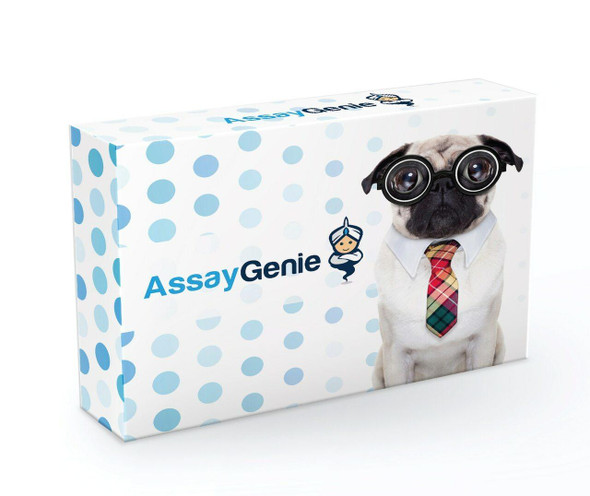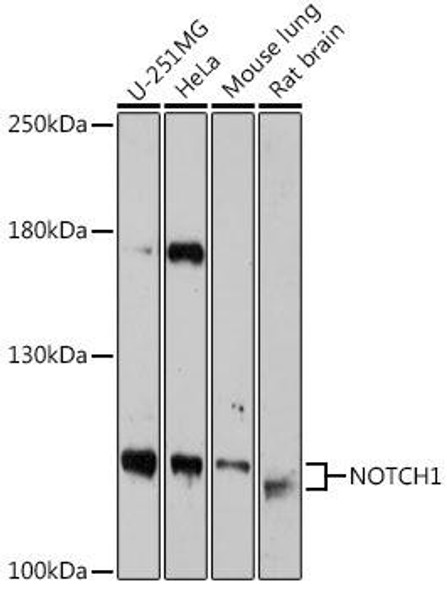Cell Biology Antibodies 7
Anti-HNRNPD Antibody (CAB1828)
- SKU:
- CAB1828
- Product Type:
- Antibody
- Reactivity:
- Human
- Reactivity:
- Mouse
- Reactivity:
- Rat
- Host Species:
- Rabbit
- Isotype:
- IgG
- Research Area:
- Cell Biology
Description
| Antibody Name: | Anti-HNRNPD Antibody |
| Antibody SKU: | CAB1828 |
| Antibody Size: | 20uL, 50uL, 100uL |
| Application: | WB IHC IF |
| Reactivity: | Human, Mouse, Rat |
| Host Species: | Rabbit |
| Immunogen: | Recombinant fusion protein containing a sequence corresponding to amino acids 1-306 of human HNRNPD (NP_002129.2). |
| Application: | WB IHC IF |
| Recommended Dilution: | WB 1:500 - 1:2000 IHC 1:50 - 1:200 IF 1:50 - 1:100 |
| Reactivity: | Human, Mouse, Rat |
| Positive Samples: | SW620, Jurkat, 293T, HepG2, HeLa, A-549 |
| Immunogen: | Recombinant fusion protein containing a sequence corresponding to amino acids 1-306 of human HNRNPD (NP_002129.2). |
| Purification Method: | Affinity purification |
| Storage Buffer: | Store at -20'C. Avoid freeze / thaw cycles. Buffer: PBS with 0.02% sodium azide, 50% glycerol, pH7.3. |
| Isotype: | IgG |
| Sequence: | MSEE QFGG DGAA AAAT AAVG GSAG EQEG AMVA ATQG AAAA AGSG AGTG GGTA SGGT EGGS AESE GAKI DASK NEED EGHS NSSP RHSE AATA QREE WKMF IGGL SWDT TKKD LKDY FSKF GEVV DCTL KLDP ITGR SRGF GFVL FKES ESVD KVMD QKEH KLNG KVID PKRA KAMK TKEP VKKI FVGG LSPD TPEE KIRE YFGG FGEV ESIE LPMD NKTN KRRG FCFI TFKE EEPV KKIM EKKY HNVG LSKC EIKV AMSK EQYQ QQQQ WGSR GGFA GRAR GRGG DQQS GYGK VSRR GGHQ NSYK PY |
| Gene ID: | 3184 |
| Uniprot: | Q14103 |
| Cellular Location: | Cytoplasm, Nucleus |
| Calculated MW: | 30kDa/32kDa/36kDa/38kDa |
| Observed MW: | 43kDa |
| Synonyms: | HNRNPD, AUF1, AUF1A, HNRPD, P37, hnRNPD0 |
| Background: | This gene belongs to the subfamily of ubiquitously expressed heterogeneous nuclear ribonucleoproteins (hnRNPs). The hnRNPs are nucleic acid binding proteins and they complex with heterogeneous nuclear RNA (hnRNA). These proteins are associated with pre-mRNAs in the nucleus and appear to influence pre-mRNA processing and other aspects of mRNA metabolism and transport. While all of the hnRNPs are present in the nucleus, some seem to shuttle between the nucleus and the cytoplasm. The hnRNP proteins have distinct nucleic acid binding properties. The protein encoded by this gene has two repeats of quasi-RRM domains that bind to RNAs. It localizes to both the nucleus and the cytoplasm. This protein is implicated in the regulation of mRNA stability. Alternative splicing of this gene results in four transcript variants. |
| UniProt Protein Function: | Binds with high affinity to RNA molecules that contain AU-rich elements (AREs) found within the 3'-UTR of many proto-oncogenes and cytokine mRNAs. Also binds to double- and single-stranded DNA sequences in a specific manner and functions a transcription factor. Each of the RNA-binding domains specifically can bind solely to a single-stranded non-monotonous 5'-UUAG-3' sequence and also weaker to the single-stranded 5'-TTAGGG-3' telomeric DNA repeat. Binds RNA oligonucleotides with 5'-UUAGGG-3' repeats more tightly than the telomeric single-stranded DNA 5'-TTAGGG-3' repeats. Binding of RRM1 to DNA inhibits the formation of DNA quadruplex structure which may play a role in telomere elongation. May be involved in translationally coupled mRNA turnover. Implicated with other RNA-binding proteins in the cytoplasmic deadenylation/translational and decay interplay of the FOS mRNA mediated by the major coding-region determinant of instability (mCRD) domain. May play a role in the regulation of the rhythmic expression of circadian clock core genes. Directly binds to the 3'UTR of CRY1 mRNA and induces CRY1 rhythmic translation. May also be involved in the regulation of PER2 translation. |
| NCBI Summary: | This gene belongs to the subfamily of ubiquitously expressed heterogeneous nuclear ribonucleoproteins (hnRNPs). The hnRNPs are nucleic acid binding proteins and they complex with heterogeneous nuclear RNA (hnRNA). These proteins are associated with pre-mRNAs in the nucleus and appear to influence pre-mRNA processing and other aspects of mRNA metabolism and transport. While all of the hnRNPs are present in the nucleus, some seem to shuttle between the nucleus and the cytoplasm. The hnRNP proteins have distinct nucleic acid binding properties. The protein encoded by this gene has two repeats of quasi-RRM domains that bind to RNAs. It localizes to both the nucleus and the cytoplasm. This protein is implicated in the regulation of mRNA stability. Alternative splicing of this gene results in four transcript variants. [provided by RefSeq, Jul 2008] |
| UniProt Code: | Q14103 |
| NCBI GenInfo Identifier: | 13124489 |
| NCBI Gene ID: | 3184 |
| NCBI Accession: | Q14103.1 |
| UniProt Secondary Accession: | Q14103,P07029, Q01858, Q14100, Q14101, Q14102, Q4W5A1 Q9UCE8, Q9UCE9, A8K9J2, |
| UniProt Related Accession: | Q14103 |
| Molecular Weight: | 30,672 Da |
| NCBI Full Name: | Heterogeneous nuclear ribonucleoprotein D0 |
| NCBI Synonym Full Names: | heterogeneous nuclear ribonucleoprotein D |
| NCBI Official Symbol: | HNRNPD |
| NCBI Official Synonym Symbols: | P37; AUF1; AUF1A; HNRPD; hnRNPD0 |
| NCBI Protein Information: | heterogeneous nuclear ribonucleoprotein D0 |
| UniProt Protein Name: | Heterogeneous nuclear ribonucleoprotein D0 |
| UniProt Synonym Protein Names: | AU-rich element RNA-binding protein 1 |
| Protein Family: | Heterogeneous nuclear ribonucleoprotein |
| UniProt Gene Name: | HNRNPD |
| UniProt Entry Name: | HNRPD_HUMAN |
View AllClose


